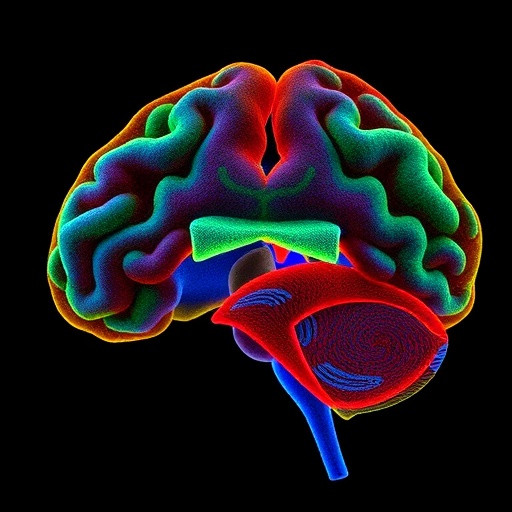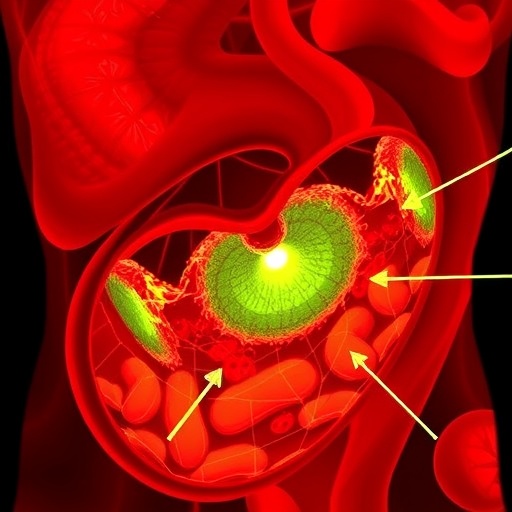In a groundbreaking study recently published in Cell Death Discovery, researchers have unveiled a novel mechanistic link between APOE4, cholesterol metabolism in atherosclerosis, and the hyperphosphorylation of tau protein within the substantia nigra. This intricate cascade potentially elucidates a key molecular pathway underpinning neurodegenerative processes associated with Parkinsonian syndromes and other tauopathies, shedding new light on the convergence of cardiovascular and neurological diseases.
Apolipoprotein E4 (APOE4), a well-established genetic risk factor predominantly implicated in Alzheimer’s disease, has now been implicated in provoking pathological tau modifications in the midbrain dopaminergic neurons that reside in the substantia nigra. These findings suggest a profound interplay between peripheral vascular health and central nervous system proteinopathy, linking atherosclerotic dysregulation directly to neuronal vulnerability in specific brain regions.
Cholesterol homeostasis emerges as a critical mediator in this pathological axis. The researchers have demonstrated that the presence of APOE4 exacerbates cholesterol accumulation within atherosclerotic plaques, which in turn precipitates an environment conducive to abnormal tau phosphorylation. This hyperphosphorylation of tau within nigral cells may disrupt microtubule stability and intracellular transport, thereby fostering neurodegenerative cascades that culminate in cell death.
Utilizing sophisticated in vivo models that mimic human-like atherosclerotic pathology alongside targeted neuronal assessments, the study details how APOE4 accelerates atherosclerotic lesion development while simultaneously triggering aberrant tau modifications in dopaminergic neurons. This dual pathology suggests that cardiovascular health and neural integrity are more intimately connected than previously recognized, especially in the context of APOE4 carriers.
Biochemical assays revealed elevated levels of phosphorylated tau epitopes specifically within the nigral region, concomitant with increased cholesterol deposition. The hyperphosphorylation sites correspond to those known to impair tau’s ability to stabilize microtubules, a finding that implicates cholesterol dysregulation as a facilitator of tau-mediated neurotoxicity.
The study further explores the cellular pathways activated downstream of cholesterol build-up, identifying key kinases responsible for tau phosphorylation that are upregulated in the APOE4 context. This points to potential therapeutic targets that might interrupt the pathological signal transduction linking cholesterol accumulation in blood vessels with intracellular protein malformations in neurons.
Importantly, this research emphasizes the subtleties of regional brain vulnerability. While APOE4-related tauopathy is often studied in hippocampal and cortical neurons, the substantia nigra—a critical site affected in Parkinson’s disease—exhibits distinct susceptibility, likely due to unique metabolic demands and cholesterol dynamics intrinsic to this brain area.
The pathophysiological relevance of atherosclerosis-mediated tau hyperphosphorylation in the substantia nigra raises significant clinical questions. Could managing cholesterol more aggressively in APOE4 carriers mitigate neurodegeneration? Does targeting tau phosphorylation in nigral neurons represent a viable intervention in patients with comorbid cardiovascular and neurodegenerative conditions?
This study’s integration of neuropathological insights with vascular biology resonates deeply with the emerging field of neurovascular coupling, which acknowledges that vascular impairments profoundly influence neurodegeneration. APOE4 appears to act as a genetic amplifier within this axis, exacerbating cholesterol abnormalities that ripple outward as lethal neuronal proteinopathies.
Through advanced imaging techniques and molecular profiling, the research team mapped out the spatial correlation between cholesterol-rich atherosclerotic plaques in cerebral vessels and tau pathology in the adjacent neural parenchyma. This spatial proximity underscores the mechanistic plausibility of vascular-derived biochemical perturbations directly influencing neuronal protein modifications.
The implications of these findings extend beyond fundamental neuroscience, beckoning a multidisciplinary approach combining cardiology, neurology, and molecular genetics toward collaborative strategies for early diagnosis and targeted therapies. Monitoring atherosclerotic burden and cholesterol metabolism might become integral in predicting and managing neurodegenerative diseases in APOE4 populations.
Moreover, this work challenges existing paradigms that treat hyperphosphorylated tau as a predominantly neuron-autonomous pathology by positioning vascular factors as critical upstream contributors. Such a reframing could revolutionize therapeutic approaches by incorporating systemic vascular health into neurodegenerative disease models.
The intersection of APOE4, cholesterol, and tau hyperphosphorylation revealed in this study exemplifies the complexity underlying multifactorial diseases where genetic predispositions interface with metabolic and vascular disturbances. This knowledge opens avenues for precision medicine tailored to genetic backgrounds combined with lifestyle and metabolic interventions.
Future research building on these findings may involve delineating the exact kinase pathways activated by cholesterol in vivo, exploring temporal dynamics of tau hyperphosphorylation relative to plaque progression, and developing small molecules or biologics that can modulate this pathway effectively, thereby preventing neuronal loss in the substantia nigra.
Ultimately, the study by Hu and colleagues delivers a pivotal advance in understanding how a common genetic variant intensifies neurological damage by harnessing vascular pathology, reinforcing the concept that brain health is inexorably linked with the cardiovascular system via complex biochemical and molecular pathways with clinical relevance for aged populations.
Subject of Research: APOE4-mediated tau hyperphosphorylation in the substantia nigra driven by cholesterol accumulation in atherosclerosis.
Article Title: APOE4 promotes nigral tau hyperphosphorylation through cholesterol in atherosclerosis.
Article References:
Hu, S., Peng, X., Xia, B. et al. APOE4 promotes nigral tau hyperphosphorylation through cholesterol in atherosclerosis. Cell Death Discov. 11, 478 (2025). https://doi.org/10.1038/s41420-025-02778-1
Image Credits: AI Generated
DOI: https://doi.org/10.1038/s41420-025-02778-1
Tags: APOE4 and tau phosphorylationAPOE4 effects on vascular healthatherosclerosis and neurodegenerative processescholesterol accumulation in atherosclerotic plaquescholesterol metabolism in neurodegenerationgenetic risk factors in Alzheimer’s diseasehyperphosphorylation of tau proteinlink between cardiovascular and neurological diseasesmechanistic pathways in tauopathiesmicrotubule stability and cell deathneuronal vulnerability in midbrain dopaminergic neuronssubstantia nigra and tauopathies





